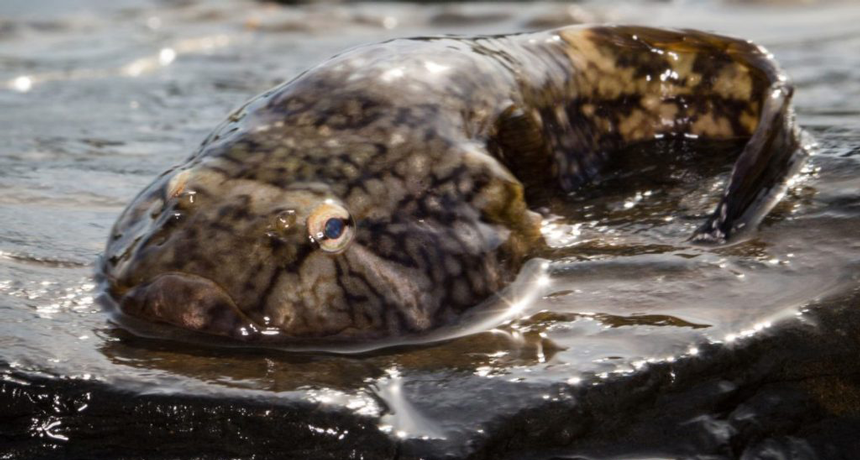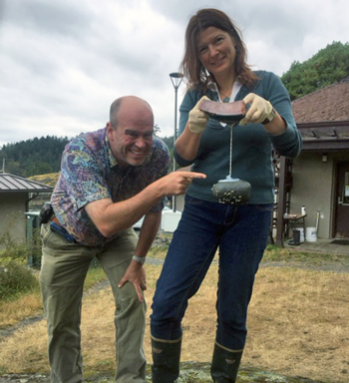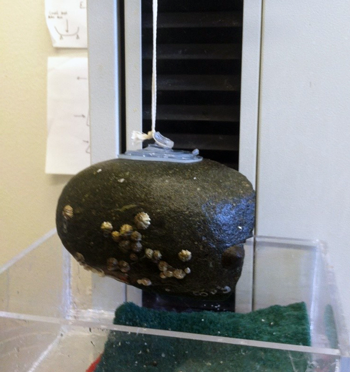Weird little fish inspires the development of super-grippers
One version can hold a 5-kilogram (11-pound) rock or firmly adhere to whale skin

This finger-sized northern clingfish was the inspiration for the new technology. Its rock-grabbing abilities led to the creation of a rugged and super-strong suction cup.
Petra Ditsche
By Sid Perkins
Suction cups are pretty handy. They can hold up a shaving mirror in the shower or hang a small picture on a living-room wall. But these devices don’t work on all surfaces or hold heavy objects. At least they didn’t until now. Researchers report having built super-suction devices modeled on the rock-grabbing tricks of the aptly named clingfish.
The finger-sized northern clingfish (Gobiesox maeandricus) lives along the Pacific coast of North America. It ranges from southern Alaska to just south of the U.S.-Mexico border, notes Petra Ditsche. As a biomechanicist (BI-oh-meh-KAN-ih-sizt), she studies how living things move. She investigated the clingfish’s gripping prowess while working at the University of Washington in Friday Harbor.
Northern clingfish tend to live in intertidal zones. Such coastal areas are submerged during high tide but dry out at low tide. That can make them tough places to hang out. Currents can swish back and forth powerfully between rocks there, Ditsche notes. And the pounding surf can easily wash away anything that isn’t firmly affixed to the rocks. Over many generations, clingfish developed the ability to hold onto the rocks, despite buffeting from waves and strong currents. A fish’s pectoral fins and pelvic fins form a suction cup of sorts under its belly. (Pectoral fins project from the side of a fish, just behind its head. Pelvic fins project underneath a fish.)
The fins’ hold is powerful, Ditsche’s tests show. Even when a rock’s surface is rough and slick, these fish can withstand a pulling force equal to more than 150 times their weight!

Biomimicry is the creation of new designs or technologies based on those seen in living organisms. For their biomimicry, Ditsche and teammate Adam Summers took a lesson from this odd little creature. They found the key to the clingfish’s super grip in the fringe of the cup-like structure formed by its belly fins. That fringe formed a good seal at the edge of the cup. A small leak there would allow gases or liquids to flow out. That would ruin the pressure difference between the underside of the cup and the world outside of it. And it’s that pressure difference that ultimately holds the fish to a surface.
Tiny structures called papillae cover the edges of the fish’s fins. Each papilla measures about 150 micrometers (6 one-thousandths of an inch) across. The papillae are covered with small rods. Even tinier filaments cover the rods. This ever-branching pattern allows the edge of the suction cup to flex easily. That means it can even mold to fit rough surfaces — such as your average rock.
An ever-branching pattern would be difficult to manufacture, Ditsche and Summers realized. So instead, they chose to make their suction cup out of a super-flexible material. This had a downside, however. A suction cup made from it would warp if anyone tried to pull it off a surface. And that would break the seal needed for the cup to work. To solve this problem, Ditsche and Summers took yet another hint from the clingfish.
Nature has reinforced fins of this fish with bones. This prevents warping of the super-flexible fin tissue. To serve the same reinforcing role, the researchers added an outer layer of stiff material to their device. It prevents almost all the warping that could jeopardize the device’s ability to grip. To help limit slippage in their flexible material, they mixed in some tiny bits of a tough material. It ups the friction exerted against the surface to which it’s attached.
Ditsche and Summers described their innovative device September 9 in Philosophical Transactions of the Royal Society B.
Long-lasting suction
The new device can adhere to rough surfaces so long as any existing bumps are smaller than 270 micrometers (0.01 inch) across. Once attached, the cup’s grip can be quite long-lasting. One suction cup held its grip on a rock underwater for three weeks, Ditsche notes. “We only stopped that test because someone else needed the tank,” she explains.

In a more informal test, one of the suction cups remained stuck to Ditsche’s office wall for months. It never fell off. She only took it down when she moved out of that office.
“I’m amazed at how well the design works,” says Takashi Maie. He’s a vertebrate anatomist at the University of Lynchburg in Virginia. He has studied other fish with similar suction-cup-like fins. Those fish, however, use their oddly arranged fins to help them climb waterfalls in Hawaii.
Ditsche and Summers can imagine lots of uses for their new grippers. In addition to handling jobs around the house, they could help strap down cargo in trucks. Or, they could attach sensors to ships or other underwater surfaces. The suction cups might even be used to attach migration-tracking sensors to whales, the researchers propose. That means that scientists wouldn’t need to pierce the animal’s skin to attach a tag. Besides reducing pain, that method of tagging would also reduce the risk of infection.
The team has written “a really neat paper, from start to finish,” says Heiko Schoenfuss. He’s an anatomist at St. Cloud State University in Minnesota. “It’s great to see the translation of basic research to something that could be immediately applicable to the real world.”
This is one in a series presenting news on technology and innovation, made possible with generous support from the Lemelson Foundation.







